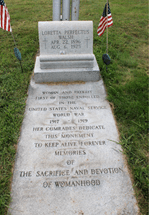By James L. Leuci, MCPO, USN (Ret.)
On 24 October 1937, over 2,000 people assembled to witness the dedication of a monument to the first woman enrolled in the United States Naval Reserve Force. Many of the people attending the memorial service were female Navy veterans of World War I–Yeoman (F) Sailors. Twenty years earlier, Loretta Walsh made history by enlisting in the Naval Reserve just prior to the United States entering World War I. She was sworn in by Lieutenant Commander Frederick R. Payne, USN in Philadelphia, PA on 21 March 1917. She became the first of 11,000 women to serve in the Navy during the war.
Loretta Perfectus Walsh was born on April 22, 1896 in Olyphant, PA. She attended St. Patrick’s Parochial & High Schools in Olyphant and Scranton & Lackawanna Business College in Scranton, PA. After graduating from Business College, she went to work as a clerk for the Navy League in Philadelphia, PA. Walsh worked for Mrs. Payne, an organizer of the “Woman’s Section of the Navy League for Preparedness” and the wife of Lieutenant Commander Frederick R. Payne. LCDR Payne served as the Executive Officer of the Philadelphia Naval Home and supervisor over all the Navy enlistments in the city. In the spring of 1917, the United States began preparing for inevitability of going to war. However, men had not been enlisting in sufficient numbers to meet the demand. On 19 March 1917, Secretary of the Navy Josephus Daniels determined that women could be enrolled in the U.S. Naval Reserve Force and issued an order authorizing their enlistment.
A few days later, LCDR Payne received permission from the Commandant of the 4th Naval District to enlist one woman with the idea that the enlistment of a woman might prompt, or shame, young men to enlist. Payne asked Loretta Walsh if she would enlist in the Naval Reserve Force as a Chief Yeoman. She immediately agreed. On 21 March 1917, after procuring and modifying a male Chief Petty Officer’s uniform, he presided over the enlistment of Chief Yeoman (F) Walsh at the Naval Home.
Chief Walsh’s enlistment was covered by newspapers in Philadelphia and across the nation. Reporters were told of the necessity to enlist women because not enough men were enlisting. The ploy worked and over the following days, before the declaration of war, the enlistment men, and women, dramatically increased.
Loretta Walsh was assigned to the Philadelphia Naval Home. She also volunteered to work in the naval hospital during the peak of the influenza epidemic in 1918. On 7 August 1919, she was discharged because of a service-connected disability and entered the U.S. Naval Hospital, Denver, Colorado. She died on 16 August 1925, due to complications related to tuberculosis and was buried in St Patrick’s Cemetery in Olyphant, PA.
In 1928, the National Yeomen F (NYF) society of female Navy veterans of World War I was incorporated “for patriotic, historical, and educational purposes…” In 1934, the NYF began a campaign to have Loretta Walsh’s remains moved to Arlington Cemetery and have a monument erected and an area set aside for the future graves of female Navy veterans of the Great War. However, their attempts did not succeed due to government policy related to Arlington Cemetery. Instead, funds were raised by NYF and other veterans organizations for a monument dedicated at Walsh’s grave in 1937. Ironically, the date of her death, on her grave stone, is in error.
Today, the NYF no longer exists since all of the veterans have passed. However, the monument for Navy women of WWI still stands today at the grave of Chief Yeoman (F) Loretta P. Walsh–the first female Citizen-Sailor.



